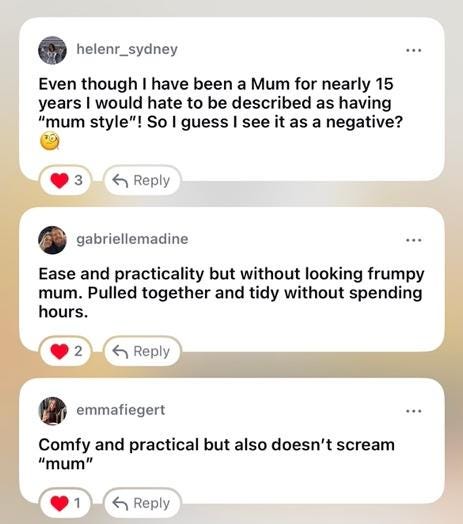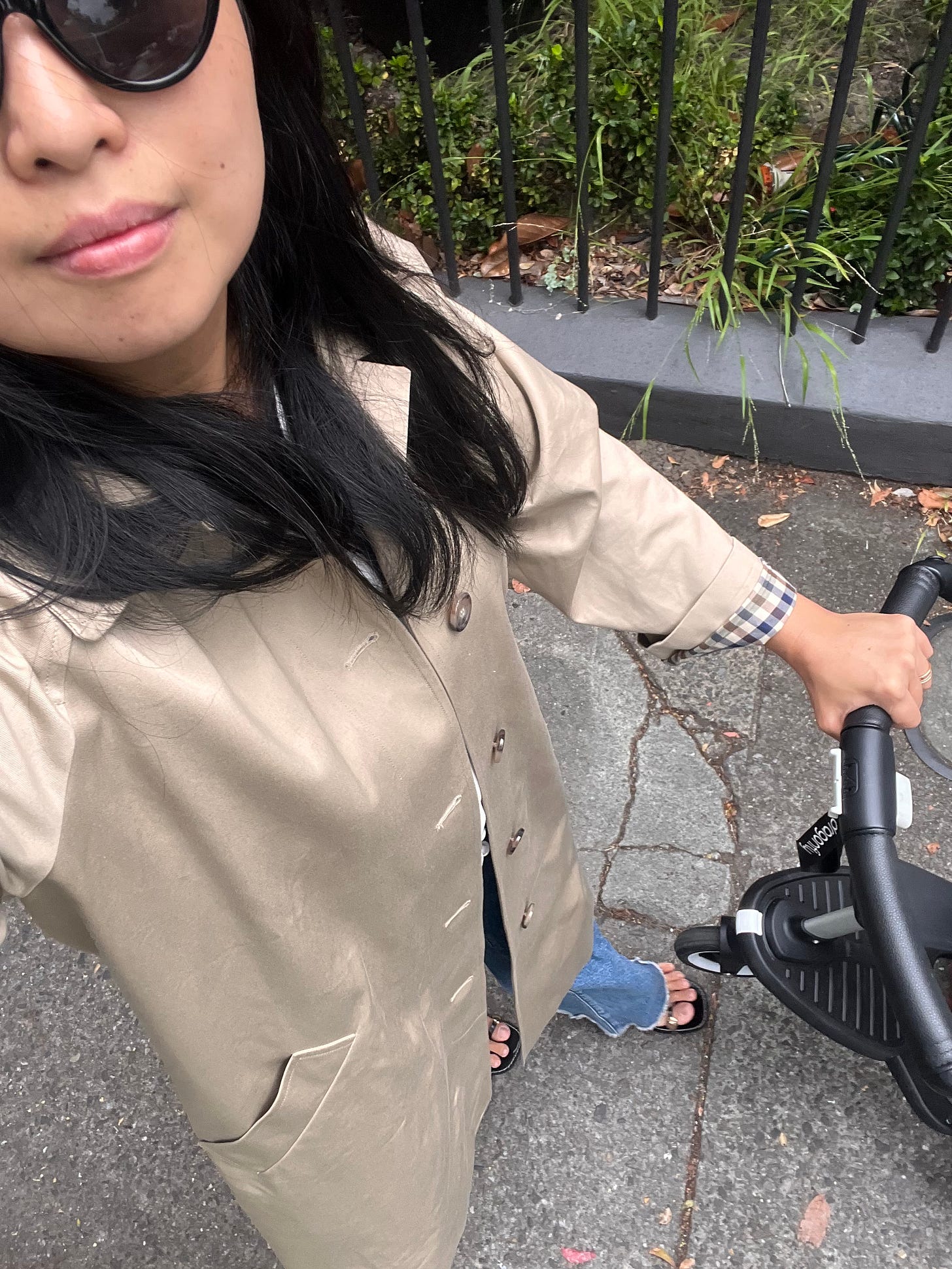The definitional shift of ‘mum style’
Using fashion to work out big life changes (and how I felt as a mother).
My first baby was a dawdling slow feeder and a catnapper, so I’d frequently be trapped on the couch. I was bored and missed adult interactions (this was in 2022; the fear of The Pandemic was still present), so I opened up my Instagram Q&As to take on shopping and fashion questions. Often, requests would read: “Flat shoes? PS I’m a mum!”
There it was, that qualifying detail: “For the playground.” “Just a mum!” “Oh, I have kids!”
Being in the early newborn stage, I was deep in the territory of dressing gowns and stretch jersey myself, so while I was not exactly at the height of chic myself, this was not a stylistic path I wanted to continue – I’d like to think it was a short, temporary blip. This too, shall past, I thought to myself.
After over a decade working in fashion and beauty industries and with a natural inclination towards them, I had always strongly felt that how I dressed and presented myself was a form of communication, of self-expression. The Oxford Learner’s Dictionary defines mumsy as: “comfortable or old-fashioned in a way that is thought of as typical of a kind mother, but lacking excitement or style.” Offt. Who wants to be saying that?
Maybe in some ways, I was the classic millennial mum, into the whole parenting idea, but also slightly apprehensive because of all the connotations around it.
I asked my Instagram broadcast channel what ‘mum style’ meant to them.
The reticence to not be considered ‘mumsy’ wasn’t just me.
But, I wondered if there was an internalised misogyny in how I viewed motherhood and by extension, mum style.
A few years ago I had heard that a newly-pregnant influencer had noticed brands that she had previously worked with suddenly dropping off, citing that they ‘didn’t want to look like they made maternity wear’. The not-so-subtle implication being that pregnancy or new mum dressing was not right for the brand’s image.
Of course, influencers who are pregnant and show their mothering very visibly on their social medias are now making mint, it points to the underlying societal sentiment that motherhood is dowdy and not worthy for a brand to be aligned to. Daggy, as we would say in Australia.
The rise of ‘Rich Mom Energy’ (I feel like the American spelling for ‘mum’ is relevant here) predominantly on TikTok added a bit of welcome allure to this corner of the styling world. It captures a look that looks polished, aspirational and well, rich, whilst also practical, and maybe most importantly, that they didn’t take that much time to pull it together. Rich Mom Energy is about making it look effortless even though it takes time (and money) to achieve. I think this is why it was picked up so widely – it is so diametrically opposite to conventional views of mum style that even if the name is so ostentatious, it broadens the definition of mum style for an audience desperate for a bit more latitude.
The term matrescence (not recognised by my Word Doc spell check, by the way) was coined in the 1970s by anthropologist Dana Raphael to describe the process of becoming a mother. The operative word being ‘process’, of course – it’s always happening and ever evolving, and there’s not a definitive destination.
The extreme polarities of ‘not being a mother’ and then suddenly ‘being a mother’ is a reductive framework where women are either one or the other, and extends to style too. Conventionally ‘mum dressing’ is functional, practical, out-of-the-loop. Frumpy. Dumpy. Lots of adjectives that have the letter ‘u’ in them – like a visual assonance with the word ‘mum’. The assumption being that mothers are so self-sacrificing prioritising their children and family above all, they surely can’t spend any time on themselves, right?
Chelsea Conaboy, author of Mother Brain: How Neuroscience is Rewriting the Story of Parenthood, explains how modern parenthood has been shaped. While the work of many thought leaders in the 20th century have shaped the understanding of parenthood for the better, these works often also prioritised maternal love above all else:
“… While practically ignoring the broader social context of a family's life or the developmental needs of a mother herself… [this] has shaped parenting advice in the decades since, and the degree to which our conceptualization of a healthy infancy is based on the devotion and presence of a mother… It promotes discrimination against families that don't include a gestational mother. It amplifies racism and classism toward anyone who doesn't perform an “ideal” maternal instinct. And it is behind so much maternal anxiety about whether our behaviors and our emotions match this ideal, and what it says about us as mothers if they don't.”
There’s a judgement of women who don’t exhibit classic motherhood ideals of devotion and self-sacrifice — like taking a bit more effort in what one wears. (Because ah, there it is — fashion is considered silly! And trivial!) There’s an implication that the mother spending time on herself – craziness, right – is taking time away from her children.)
Of course, like so much in contemporary society, the nebulous picture of ideal motherhood can feel like a trap. (Cue, the mention of America Ferrera’s monologue in the Barbie movie here.) We’re chastised if we look too done-up, but also can’t look like we’ve lost the plot and are ‘letting ourselves go’ with stained tracksuit pants. Just a note – I’m not saying that the modern reinterpretation of mum style is about dressing to the nines each and every day, but nor is it feeling that you have to dial down your own style or enjoyment of fashion.
“I’m not a regular mum, I’m a cool mum,” uttered by Regina George’s mother in Mean Girls (played by Amy Poehler) rings regularly in my head. Because, being a regular mum is not something we want to be, right? Yet Poehler’s character is someone to be derided. She can’t win either way.
Motherhood triggers a reassessment of style — why we dress, and how. Something that comes naturally is now thrown into disarray because you’re weighing up between so many different decisions in a life where you’re no longer the main character, but a supporting act. Often, it’s a move towards simplicity and practicality. It’s helpful that I had my kids post-COVID, when the world prioritised comfort more than ever before. Pared-back aesthetics, lower heel heights, pockets galore. Given the prevailing sentiment of how we’re dressing overall now, I likely would have eschewed stilettos, with or without children. And while I might skip out on wearing delicate fabrics for the playground, I’ll keep them in reach for nights out.
With my firstborn, I felt at a loss identity-wise. I was no longer doing what I was good at — my job, my career — and instead found myself thrust into something I didn’t seem particularly crash-hot at: looking after a baby and Googling minutiae details about baby sleep.
While you know your life is going to change, you don’t really know until it happens. Everything is theory until it’s practice. I felt like I had subsumed my body for 40 weeks to grow a child — amazing, yes, but also a lot to give your body over to – and then almost a year of breastfeeding where I’m basically on-call for baby’s whims, appetite or otherwise. My body didn’t feel — or look — like my own for over two years. I had to size up in jeans (absolutely no way I was going to self-flagellate by wearing my usual stiff denim or buy maternity denim – purely my choice). Summer dresses had to be set aside if I needed to wear them for over three hours because they weren’t breastfeeding-friendly.
What I did hold onto, however, was my sense of personal style. What I liked, what made me happy. In that period of chaos, getting dressed became a small, daily act of joy, or distraction — a way to bridge the gap between my pre-motherhood self and this new one.
Prior to motherhood I was more of a fashion experimenter. I dabbled in bohemian styles, and sometimes went for super strict sharp minimalism looks. Perhaps it’s due to age, but now I need to really know what I like and hone into it because, practically speaking, I just have less time to play around and come up with fun looks in my downtime. I need everything in my wardrobe to work. And to work together. Stylish whilst also being practical – that’s something that mother or not, anyone would want.
Significant life changes sharpen your sense of self.
Readers of the newsletter shared with me their thoughts about this:
For me, style has always been a touchpoint: what do I like, what am I drawn to, what makes me feel like me?
We all get into a dip whereby we’re reaching for that item of clothing that is practical but gets us down; ignoring that and instead reaching for something that I really did like did make me happy. It became the common thread that tied my old life back to my new one.
To be fair, I have an advantage of having worked out what I like to wear and what my style is. It’s something I find a lot of joy in. I have a strong sense of what I like — and even through major life changes, for me, that hasn’t wavered. Just be prepared for the patina of parenthood to accumulate on your clothes: stains and rips and learn how to use your washing machine properly and find a good drycleaner. But, remember, clothes are meant to be lived in, not behind a glass in a museum of your former life.
And yes, sometimes I have let the toddler whinge or the baby cry just a beat longer just so I can put on a nice earring. It doesn’t mean I love them any less. Thank goodness for being more calm thanks to experience with a second kid; I found going from zero to one more of a shock than going from one to two. (At that point, it practically becomes a matter of scalability.)
Defining myself as a mother did take some getting used to, though. I realised my apprehension and my reticence of being called a mother was really being nervous at being put in a box. Not just how it’ll affect how I’m perceived by other people, my career and other ego-leaning parts, but also how I feel about myself. By nature, I’ve always been reluctant to be pigeonholed at all, or to align myself to certain catchcries and calling cards because I’ve always seen the grey, the in-betweens. Life isn’t just about polarities but the parts that are neither here or nor there. I’ve since realised that all the parts of me can still exist alongside being a mother, and neither subsumes one for the other.
If you liked this, you might like my Style Strategy series.










I’ve noticed that we LOVE maternity style nowadays; it’s Rhianna exposing her tummy and loads of influencers following in her wake. That all came after my pregnancies and I’m not sure I would have participated anyways BUT the acceptance remains and I’m so happy for it. I also love the way stylish women give platform to the way other moms dress- I’m thinking specifically of Cereal Aisle series- because it shows that the spectrum is broad. In so many ways mom dressing IS regular dressing with a nod to the reality of caring for another person.
Resonated with this so much - thank you! Now my kids are 6 and 8 I feel like I’m having more fun again with fashion. Comfort is still key, but make it fashion.